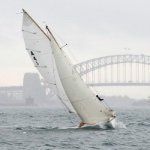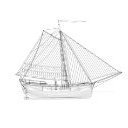-
Posts
1,580 -
Joined
-
Last visited
Reputation Activity
-
 vaddoc got a reaction from KeithAug in 21' Fisherman's Launch by vaddoc - FINISHED - Scale 1:10 - Plans from Howard Chapelle's "Boatbuilding"
vaddoc got a reaction from KeithAug in 21' Fisherman's Launch by vaddoc - FINISHED - Scale 1:10 - Plans from Howard Chapelle's "Boatbuilding"
Ok, time for a wee update!
I have not gone into hibernation and have done a bit of work, just did not have the time to take photos and post the progress. A lot of head scratching though, it's been a long time since I did the 3D plans and I had forgotten how everything come together. I also had forgotten that I ve used beech for the hull and generally cut a few corners in this boat. Now these are biting back! I simply cannot understand why I used for the frames the cheapest, nastiest plywood ever made!
So, first I had to deal with the hull and the dancing/shrinking beech wood. I filled the cracks but brought the boat inside as it was freezing cold in the garage. Yep, the wood contracted again and the sims opened once again!
I filled again, sanded, filled, sanded... I have now settled with Osmo water based filler and Decoart water based sealer - excellent products.
So, after lots of filling, sanding, scraping etc, the hull looks decent, is sanded to 400 grit and is sealed inside and out. This took time, effort, a few lungfuls of dust and lots of cursing.
Ok, time to free the boat from its cradle!
Now, the boat needs inside planking, bulkheads a bit of deck fore and aft, floor boards, the engine box, the fish well, a rudder, and this elusive vertical rudder. So here it goes:
I could not remember how all were supposed to come together and it took me a long time to figure the boat out again. I am still not sure how the floor boards and inner planking should be arranged. In any case, I installed the sheer clamps and the two bulkheads fore and aft. I had to deviate a bit from the plans due to my corner cutting. I also cut several of the frame extensions and made two braces to make sure the hull does not loose its shape.
I also bought a new water stone 1000/6000 and honed again all my chisels - they are now truly razor sharp. I also did all the kitchen knives including the serrated bread knives - all now very sharp!
Much to do and at some point I must paint the hull. I have no doubt the beech will find a new moisture equilibrium and the sims will open up again so it needs to be done asap but it is -2C in England currently so painting will have to wait. I 've decided to use enamels and top it up with enamel varnish - all brush painted. Have not used enamels in many years!
Till next time, my very best wishes for the New Year!
Vaddoc
-
 vaddoc got a reaction from GrandpaPhil in 21' Fisherman's Launch by vaddoc - FINISHED - Scale 1:10 - Plans from Howard Chapelle's "Boatbuilding"
vaddoc got a reaction from GrandpaPhil in 21' Fisherman's Launch by vaddoc - FINISHED - Scale 1:10 - Plans from Howard Chapelle's "Boatbuilding"
Ok, time for a wee update!
I have not gone into hibernation and have done a bit of work, just did not have the time to take photos and post the progress. A lot of head scratching though, it's been a long time since I did the 3D plans and I had forgotten how everything come together. I also had forgotten that I ve used beech for the hull and generally cut a few corners in this boat. Now these are biting back! I simply cannot understand why I used for the frames the cheapest, nastiest plywood ever made!
So, first I had to deal with the hull and the dancing/shrinking beech wood. I filled the cracks but brought the boat inside as it was freezing cold in the garage. Yep, the wood contracted again and the sims opened once again!
I filled again, sanded, filled, sanded... I have now settled with Osmo water based filler and Decoart water based sealer - excellent products.
So, after lots of filling, sanding, scraping etc, the hull looks decent, is sanded to 400 grit and is sealed inside and out. This took time, effort, a few lungfuls of dust and lots of cursing.
Ok, time to free the boat from its cradle!
Now, the boat needs inside planking, bulkheads a bit of deck fore and aft, floor boards, the engine box, the fish well, a rudder, and this elusive vertical rudder. So here it goes:
I could not remember how all were supposed to come together and it took me a long time to figure the boat out again. I am still not sure how the floor boards and inner planking should be arranged. In any case, I installed the sheer clamps and the two bulkheads fore and aft. I had to deviate a bit from the plans due to my corner cutting. I also cut several of the frame extensions and made two braces to make sure the hull does not loose its shape.
I also bought a new water stone 1000/6000 and honed again all my chisels - they are now truly razor sharp. I also did all the kitchen knives including the serrated bread knives - all now very sharp!
Much to do and at some point I must paint the hull. I have no doubt the beech will find a new moisture equilibrium and the sims will open up again so it needs to be done asap but it is -2C in England currently so painting will have to wait. I 've decided to use enamels and top it up with enamel varnish - all brush painted. Have not used enamels in many years!
Till next time, my very best wishes for the New Year!
Vaddoc
-
 vaddoc got a reaction from Harvey Golden in 21' Fisherman's Launch by vaddoc - FINISHED - Scale 1:10 - Plans from Howard Chapelle's "Boatbuilding"
vaddoc got a reaction from Harvey Golden in 21' Fisherman's Launch by vaddoc - FINISHED - Scale 1:10 - Plans from Howard Chapelle's "Boatbuilding"
Ok, time for a wee update!
I have not gone into hibernation and have done a bit of work, just did not have the time to take photos and post the progress. A lot of head scratching though, it's been a long time since I did the 3D plans and I had forgotten how everything come together. I also had forgotten that I ve used beech for the hull and generally cut a few corners in this boat. Now these are biting back! I simply cannot understand why I used for the frames the cheapest, nastiest plywood ever made!
So, first I had to deal with the hull and the dancing/shrinking beech wood. I filled the cracks but brought the boat inside as it was freezing cold in the garage. Yep, the wood contracted again and the sims opened once again!
I filled again, sanded, filled, sanded... I have now settled with Osmo water based filler and Decoart water based sealer - excellent products.
So, after lots of filling, sanding, scraping etc, the hull looks decent, is sanded to 400 grit and is sealed inside and out. This took time, effort, a few lungfuls of dust and lots of cursing.
Ok, time to free the boat from its cradle!
Now, the boat needs inside planking, bulkheads a bit of deck fore and aft, floor boards, the engine box, the fish well, a rudder, and this elusive vertical rudder. So here it goes:
I could not remember how all were supposed to come together and it took me a long time to figure the boat out again. I am still not sure how the floor boards and inner planking should be arranged. In any case, I installed the sheer clamps and the two bulkheads fore and aft. I had to deviate a bit from the plans due to my corner cutting. I also cut several of the frame extensions and made two braces to make sure the hull does not loose its shape.
I also bought a new water stone 1000/6000 and honed again all my chisels - they are now truly razor sharp. I also did all the kitchen knives including the serrated bread knives - all now very sharp!
Much to do and at some point I must paint the hull. I have no doubt the beech will find a new moisture equilibrium and the sims will open up again so it needs to be done asap but it is -2C in England currently so painting will have to wait. I 've decided to use enamels and top it up with enamel varnish - all brush painted. Have not used enamels in many years!
Till next time, my very best wishes for the New Year!
Vaddoc
-
 vaddoc got a reaction from Wintergreen in 21' Fisherman's Launch by vaddoc - FINISHED - Scale 1:10 - Plans from Howard Chapelle's "Boatbuilding"
vaddoc got a reaction from Wintergreen in 21' Fisherman's Launch by vaddoc - FINISHED - Scale 1:10 - Plans from Howard Chapelle's "Boatbuilding"
Ok, time for a wee update!
I have not gone into hibernation and have done a bit of work, just did not have the time to take photos and post the progress. A lot of head scratching though, it's been a long time since I did the 3D plans and I had forgotten how everything come together. I also had forgotten that I ve used beech for the hull and generally cut a few corners in this boat. Now these are biting back! I simply cannot understand why I used for the frames the cheapest, nastiest plywood ever made!
So, first I had to deal with the hull and the dancing/shrinking beech wood. I filled the cracks but brought the boat inside as it was freezing cold in the garage. Yep, the wood contracted again and the sims opened once again!
I filled again, sanded, filled, sanded... I have now settled with Osmo water based filler and Decoart water based sealer - excellent products.
So, after lots of filling, sanding, scraping etc, the hull looks decent, is sanded to 400 grit and is sealed inside and out. This took time, effort, a few lungfuls of dust and lots of cursing.
Ok, time to free the boat from its cradle!
Now, the boat needs inside planking, bulkheads a bit of deck fore and aft, floor boards, the engine box, the fish well, a rudder, and this elusive vertical rudder. So here it goes:
I could not remember how all were supposed to come together and it took me a long time to figure the boat out again. I am still not sure how the floor boards and inner planking should be arranged. In any case, I installed the sheer clamps and the two bulkheads fore and aft. I had to deviate a bit from the plans due to my corner cutting. I also cut several of the frame extensions and made two braces to make sure the hull does not loose its shape.
I also bought a new water stone 1000/6000 and honed again all my chisels - they are now truly razor sharp. I also did all the kitchen knives including the serrated bread knives - all now very sharp!
Much to do and at some point I must paint the hull. I have no doubt the beech will find a new moisture equilibrium and the sims will open up again so it needs to be done asap but it is -2C in England currently so painting will have to wait. I 've decided to use enamels and top it up with enamel varnish - all brush painted. Have not used enamels in many years!
Till next time, my very best wishes for the New Year!
Vaddoc
-
 vaddoc got a reaction from wefalck in 21' Fisherman's Launch by vaddoc - FINISHED - Scale 1:10 - Plans from Howard Chapelle's "Boatbuilding"
vaddoc got a reaction from wefalck in 21' Fisherman's Launch by vaddoc - FINISHED - Scale 1:10 - Plans from Howard Chapelle's "Boatbuilding"
Ok, time for a wee update!
I have not gone into hibernation and have done a bit of work, just did not have the time to take photos and post the progress. A lot of head scratching though, it's been a long time since I did the 3D plans and I had forgotten how everything come together. I also had forgotten that I ve used beech for the hull and generally cut a few corners in this boat. Now these are biting back! I simply cannot understand why I used for the frames the cheapest, nastiest plywood ever made!
So, first I had to deal with the hull and the dancing/shrinking beech wood. I filled the cracks but brought the boat inside as it was freezing cold in the garage. Yep, the wood contracted again and the sims opened once again!
I filled again, sanded, filled, sanded... I have now settled with Osmo water based filler and Decoart water based sealer - excellent products.
So, after lots of filling, sanding, scraping etc, the hull looks decent, is sanded to 400 grit and is sealed inside and out. This took time, effort, a few lungfuls of dust and lots of cursing.
Ok, time to free the boat from its cradle!
Now, the boat needs inside planking, bulkheads a bit of deck fore and aft, floor boards, the engine box, the fish well, a rudder, and this elusive vertical rudder. So here it goes:
I could not remember how all were supposed to come together and it took me a long time to figure the boat out again. I am still not sure how the floor boards and inner planking should be arranged. In any case, I installed the sheer clamps and the two bulkheads fore and aft. I had to deviate a bit from the plans due to my corner cutting. I also cut several of the frame extensions and made two braces to make sure the hull does not loose its shape.
I also bought a new water stone 1000/6000 and honed again all my chisels - they are now truly razor sharp. I also did all the kitchen knives including the serrated bread knives - all now very sharp!
Much to do and at some point I must paint the hull. I have no doubt the beech will find a new moisture equilibrium and the sims will open up again so it needs to be done asap but it is -2C in England currently so painting will have to wait. I 've decided to use enamels and top it up with enamel varnish - all brush painted. Have not used enamels in many years!
Till next time, my very best wishes for the New Year!
Vaddoc
-
 vaddoc got a reaction from BobG in 21' Fisherman's Launch by vaddoc - FINISHED - Scale 1:10 - Plans from Howard Chapelle's "Boatbuilding"
vaddoc got a reaction from BobG in 21' Fisherman's Launch by vaddoc - FINISHED - Scale 1:10 - Plans from Howard Chapelle's "Boatbuilding"
Ok, time for a wee update!
I have not gone into hibernation and have done a bit of work, just did not have the time to take photos and post the progress. A lot of head scratching though, it's been a long time since I did the 3D plans and I had forgotten how everything come together. I also had forgotten that I ve used beech for the hull and generally cut a few corners in this boat. Now these are biting back! I simply cannot understand why I used for the frames the cheapest, nastiest plywood ever made!
So, first I had to deal with the hull and the dancing/shrinking beech wood. I filled the cracks but brought the boat inside as it was freezing cold in the garage. Yep, the wood contracted again and the sims opened once again!
I filled again, sanded, filled, sanded... I have now settled with Osmo water based filler and Decoart water based sealer - excellent products.
So, after lots of filling, sanding, scraping etc, the hull looks decent, is sanded to 400 grit and is sealed inside and out. This took time, effort, a few lungfuls of dust and lots of cursing.
Ok, time to free the boat from its cradle!
Now, the boat needs inside planking, bulkheads a bit of deck fore and aft, floor boards, the engine box, the fish well, a rudder, and this elusive vertical rudder. So here it goes:
I could not remember how all were supposed to come together and it took me a long time to figure the boat out again. I am still not sure how the floor boards and inner planking should be arranged. In any case, I installed the sheer clamps and the two bulkheads fore and aft. I had to deviate a bit from the plans due to my corner cutting. I also cut several of the frame extensions and made two braces to make sure the hull does not loose its shape.
I also bought a new water stone 1000/6000 and honed again all my chisels - they are now truly razor sharp. I also did all the kitchen knives including the serrated bread knives - all now very sharp!
Much to do and at some point I must paint the hull. I have no doubt the beech will find a new moisture equilibrium and the sims will open up again so it needs to be done asap but it is -2C in England currently so painting will have to wait. I 've decided to use enamels and top it up with enamel varnish - all brush painted. Have not used enamels in many years!
Till next time, my very best wishes for the New Year!
Vaddoc
-
 vaddoc got a reaction from Bedford in 21' Fisherman's Launch by vaddoc - FINISHED - Scale 1:10 - Plans from Howard Chapelle's "Boatbuilding"
vaddoc got a reaction from Bedford in 21' Fisherman's Launch by vaddoc - FINISHED - Scale 1:10 - Plans from Howard Chapelle's "Boatbuilding"
Ok, time for a wee update!
I have not gone into hibernation and have done a bit of work, just did not have the time to take photos and post the progress. A lot of head scratching though, it's been a long time since I did the 3D plans and I had forgotten how everything come together. I also had forgotten that I ve used beech for the hull and generally cut a few corners in this boat. Now these are biting back! I simply cannot understand why I used for the frames the cheapest, nastiest plywood ever made!
So, first I had to deal with the hull and the dancing/shrinking beech wood. I filled the cracks but brought the boat inside as it was freezing cold in the garage. Yep, the wood contracted again and the sims opened once again!
I filled again, sanded, filled, sanded... I have now settled with Osmo water based filler and Decoart water based sealer - excellent products.
So, after lots of filling, sanding, scraping etc, the hull looks decent, is sanded to 400 grit and is sealed inside and out. This took time, effort, a few lungfuls of dust and lots of cursing.
Ok, time to free the boat from its cradle!
Now, the boat needs inside planking, bulkheads a bit of deck fore and aft, floor boards, the engine box, the fish well, a rudder, and this elusive vertical rudder. So here it goes:
I could not remember how all were supposed to come together and it took me a long time to figure the boat out again. I am still not sure how the floor boards and inner planking should be arranged. In any case, I installed the sheer clamps and the two bulkheads fore and aft. I had to deviate a bit from the plans due to my corner cutting. I also cut several of the frame extensions and made two braces to make sure the hull does not loose its shape.
I also bought a new water stone 1000/6000 and honed again all my chisels - they are now truly razor sharp. I also did all the kitchen knives including the serrated bread knives - all now very sharp!
Much to do and at some point I must paint the hull. I have no doubt the beech will find a new moisture equilibrium and the sims will open up again so it needs to be done asap but it is -2C in England currently so painting will have to wait. I 've decided to use enamels and top it up with enamel varnish - all brush painted. Have not used enamels in many years!
Till next time, my very best wishes for the New Year!
Vaddoc
-
 vaddoc got a reaction from Mark Pearse in 21' Fisherman's Launch by vaddoc - FINISHED - Scale 1:10 - Plans from Howard Chapelle's "Boatbuilding"
vaddoc got a reaction from Mark Pearse in 21' Fisherman's Launch by vaddoc - FINISHED - Scale 1:10 - Plans from Howard Chapelle's "Boatbuilding"
Ok, time for a wee update!
I have not gone into hibernation and have done a bit of work, just did not have the time to take photos and post the progress. A lot of head scratching though, it's been a long time since I did the 3D plans and I had forgotten how everything come together. I also had forgotten that I ve used beech for the hull and generally cut a few corners in this boat. Now these are biting back! I simply cannot understand why I used for the frames the cheapest, nastiest plywood ever made!
So, first I had to deal with the hull and the dancing/shrinking beech wood. I filled the cracks but brought the boat inside as it was freezing cold in the garage. Yep, the wood contracted again and the sims opened once again!
I filled again, sanded, filled, sanded... I have now settled with Osmo water based filler and Decoart water based sealer - excellent products.
So, after lots of filling, sanding, scraping etc, the hull looks decent, is sanded to 400 grit and is sealed inside and out. This took time, effort, a few lungfuls of dust and lots of cursing.
Ok, time to free the boat from its cradle!
Now, the boat needs inside planking, bulkheads a bit of deck fore and aft, floor boards, the engine box, the fish well, a rudder, and this elusive vertical rudder. So here it goes:
I could not remember how all were supposed to come together and it took me a long time to figure the boat out again. I am still not sure how the floor boards and inner planking should be arranged. In any case, I installed the sheer clamps and the two bulkheads fore and aft. I had to deviate a bit from the plans due to my corner cutting. I also cut several of the frame extensions and made two braces to make sure the hull does not loose its shape.
I also bought a new water stone 1000/6000 and honed again all my chisels - they are now truly razor sharp. I also did all the kitchen knives including the serrated bread knives - all now very sharp!
Much to do and at some point I must paint the hull. I have no doubt the beech will find a new moisture equilibrium and the sims will open up again so it needs to be done asap but it is -2C in England currently so painting will have to wait. I 've decided to use enamels and top it up with enamel varnish - all brush painted. Have not used enamels in many years!
Till next time, my very best wishes for the New Year!
Vaddoc
-
 vaddoc got a reaction from Bob Cleek in 21' Fisherman's Launch by vaddoc - FINISHED - Scale 1:10 - Plans from Howard Chapelle's "Boatbuilding"
vaddoc got a reaction from Bob Cleek in 21' Fisherman's Launch by vaddoc - FINISHED - Scale 1:10 - Plans from Howard Chapelle's "Boatbuilding"
Ok, time for a wee update!
I have not gone into hibernation and have done a bit of work, just did not have the time to take photos and post the progress. A lot of head scratching though, it's been a long time since I did the 3D plans and I had forgotten how everything come together. I also had forgotten that I ve used beech for the hull and generally cut a few corners in this boat. Now these are biting back! I simply cannot understand why I used for the frames the cheapest, nastiest plywood ever made!
So, first I had to deal with the hull and the dancing/shrinking beech wood. I filled the cracks but brought the boat inside as it was freezing cold in the garage. Yep, the wood contracted again and the sims opened once again!
I filled again, sanded, filled, sanded... I have now settled with Osmo water based filler and Decoart water based sealer - excellent products.
So, after lots of filling, sanding, scraping etc, the hull looks decent, is sanded to 400 grit and is sealed inside and out. This took time, effort, a few lungfuls of dust and lots of cursing.
Ok, time to free the boat from its cradle!
Now, the boat needs inside planking, bulkheads a bit of deck fore and aft, floor boards, the engine box, the fish well, a rudder, and this elusive vertical rudder. So here it goes:
I could not remember how all were supposed to come together and it took me a long time to figure the boat out again. I am still not sure how the floor boards and inner planking should be arranged. In any case, I installed the sheer clamps and the two bulkheads fore and aft. I had to deviate a bit from the plans due to my corner cutting. I also cut several of the frame extensions and made two braces to make sure the hull does not loose its shape.
I also bought a new water stone 1000/6000 and honed again all my chisels - they are now truly razor sharp. I also did all the kitchen knives including the serrated bread knives - all now very sharp!
Much to do and at some point I must paint the hull. I have no doubt the beech will find a new moisture equilibrium and the sims will open up again so it needs to be done asap but it is -2C in England currently so painting will have to wait. I 've decided to use enamels and top it up with enamel varnish - all brush painted. Have not used enamels in many years!
Till next time, my very best wishes for the New Year!
Vaddoc
-
 vaddoc got a reaction from GrandpaPhil in Plywood for bulkheads
vaddoc got a reaction from GrandpaPhil in Plywood for bulkheads
If I need really flat strong plywood, I make it my self.
If I need 6 mm, I take two sheets 2.5 mm each on a flat surface. Thicken epoxy with gypsum, spread onto one sheet, cover with the other and put something very heavy on top. 12 h later I get very flat, very rigid 6 mm ply.
-
 vaddoc got a reaction from Canute in Keep Brass Shiny
vaddoc got a reaction from Canute in Keep Brass Shiny
Try Rennaisance wax. Invisible, dead easy to apply and will keep them shiny for ever. This is I think what museums use. My experience has been very good - I have brass pieces stay shiny for 10 years now
-
 vaddoc got a reaction from Canute in Plywood for bulkheads
vaddoc got a reaction from Canute in Plywood for bulkheads
If I need really flat strong plywood, I make it my self.
If I need 6 mm, I take two sheets 2.5 mm each on a flat surface. Thicken epoxy with gypsum, spread onto one sheet, cover with the other and put something very heavy on top. 12 h later I get very flat, very rigid 6 mm ply.
-
 vaddoc got a reaction from mtaylor in Plywood for bulkheads
vaddoc got a reaction from mtaylor in Plywood for bulkheads
If I need really flat strong plywood, I make it my self.
If I need 6 mm, I take two sheets 2.5 mm each on a flat surface. Thicken epoxy with gypsum, spread onto one sheet, cover with the other and put something very heavy on top. 12 h later I get very flat, very rigid 6 mm ply.
-
 vaddoc got a reaction from mtaylor in Keep Brass Shiny
vaddoc got a reaction from mtaylor in Keep Brass Shiny
Try Rennaisance wax. Invisible, dead easy to apply and will keep them shiny for ever. This is I think what museums use. My experience has been very good - I have brass pieces stay shiny for 10 years now
-
 vaddoc got a reaction from cotrecerf in Keep Brass Shiny
vaddoc got a reaction from cotrecerf in Keep Brass Shiny
Try Rennaisance wax. Invisible, dead easy to apply and will keep them shiny for ever. This is I think what museums use. My experience has been very good - I have brass pieces stay shiny for 10 years now
-
 vaddoc got a reaction from Roger Pellett in Keep Brass Shiny
vaddoc got a reaction from Roger Pellett in Keep Brass Shiny
Try Rennaisance wax. Invisible, dead easy to apply and will keep them shiny for ever. This is I think what museums use. My experience has been very good - I have brass pieces stay shiny for 10 years now
-
 vaddoc got a reaction from Helge Hafstad in Acrylic paint tips and techniques
vaddoc got a reaction from Helge Hafstad in Acrylic paint tips and techniques
Hand brushing is a good alternative, quite satisfying as well!
I have only basic painting skills and do not want to use an airbrush. I have had excellent results with hand brushing using Valejo colours following these rules:
1. Use very good brushes, with appropriate width for the job
2. Thin the paint (should be runny but not like water), avoid heavy coats.
3. For Valejo, use the hand brushing thinner, different and better than the air brush thinner. It congeals if left so must have resin in it (this is what valejo claims so not easily reproduced at home). Get the 60 ml bottle, it is not expensive.
4. Use a bit of retarder.
5. Start from dry and end on wet. Take your time, you can go over the area 2-3 times. Avoid puddles at the edges.
6. Trust the paint! Do not go over again to "correct" or smooth out brush marks. They will disappear. You ll probably need a dozen or more coats either way.
7. Best to seal the wood, I use a water based wood sealer sanded to 400 grit
8. I use plastic pots with caps that seal pretty well and are cheap. The paint stays wet for months.
9. Use only frog tape or Tamiya tape or equivalent. The paint will bleed under ordinary masking tape or electricians tape.
10. Acrylic paint is not tough so needs to be protected with varnish or some topcoat
Hopefully these will be of help to some. May not work for all but I was able to paint my 80 cm hull with almost no brush marks.
Vaddoc
-
 vaddoc reacted to Wintergreen in Atlantica by Wintergreen – Scale 1:30 - POF - sail training ketch - a smack of English heritage
vaddoc reacted to Wintergreen in Atlantica by Wintergreen – Scale 1:30 - POF - sail training ketch - a smack of English heritage
Speaking of which...2023 soon in the books.
After my last update in early November I had a thought that I would wait with next update til the hull was all planked.
But then I thought that if you were to wait that long you'd probably would be thinking that I'd abandon ship.
So, here is an update on the planking progress. My new plan is to have the hull planking finished when I venture back to work in a litttle over a week from now. Will see how that goes...
And a rough cut stern.
The planking looks decent from a distance (remember, it is more than 30 years since I last planked a hull...), however, like Jake states in Blues Brothers: "I can see the light!" 😄
But, oatevva, thatts what caulking is for innit?
I bid you all a (select all that applies, multiple selections are possible):
- peaceful
- merry
- wild
ending to 2023 and a prosperous new 2024!
-
 vaddoc got a reaction from mtaylor in Who uses nails?
vaddoc got a reaction from mtaylor in Who uses nails?
Allan, if you google "1mm Philips self tapping screws" you ll get lots of results. I buy mine from Aliexpress, different lengths with 5 and 6 mm more useful. Last time I bought 20k!
Best is to use 0.8 mm drill. The stainless steel are better than mild steel as the head resists deforming which can make removal impossible. I have had difficulty recently finding good quality proper hard stainless steel ones (if they are non magnetic they are the good ones)
Smaller screws are extremely expensive available in very few specialist shops. However, you can thread brass wire and use it to screw things together but it is very labour intensive,
vaddoc
-
 vaddoc got a reaction from allanyed in Who uses nails?
vaddoc got a reaction from allanyed in Who uses nails?
Allan, if you google "1mm Philips self tapping screws" you ll get lots of results. I buy mine from Aliexpress, different lengths with 5 and 6 mm more useful. Last time I bought 20k!
Best is to use 0.8 mm drill. The stainless steel are better than mild steel as the head resists deforming which can make removal impossible. I have had difficulty recently finding good quality proper hard stainless steel ones (if they are non magnetic they are the good ones)
Smaller screws are extremely expensive available in very few specialist shops. However, you can thread brass wire and use it to screw things together but it is very labour intensive,
vaddoc
-
 vaddoc got a reaction from mtaylor in Who uses nails?
vaddoc got a reaction from mtaylor in Who uses nails?
1 mm screws can be useful. I ve used tens of thousands of them - replaced by treenails later.
-
 vaddoc got a reaction from fmartins in Spilling (very long) planks
vaddoc got a reaction from fmartins in Spilling (very long) planks
Dear all
As I am currently immersed in planking, I thought it might be useful to share my way of spilling planks.
In my fishing boat log I have presented in detail the way the plank run can be defined but it is a long and difficult read. Showing how to spill planks is much easier and perhaps will help some builders.
So lets spill a plank in the fishing boat. T he positions of all planks have been marked on the port side and these positions will need to be transferred over to the starboard side as we go along. The planks should be twins but in reality they never are, at least in my boats so every plank needs to be individually spilled.
A good compass is needed, this is the one I use
The plank we will be making will be a starboard plank, its sister plank on the port side is already installed. A picture is a thousand words: This is the port plank steamed in place and the markings for all the rest of the planks are visible. We need to make this plank for the other side.
Now, every new plank will have two edges. The bottom one that meets the previous plank, and this needs to be shaped so it fits well, and the upper free edge that we will define ourselves based on our markings and planning of the planks but needs to be as fair as possible.
I use either very stiff card or thick cardboard to make templates of the bottom edge. I cut pieces as long as possible, hold them close to the edge of the previous plank and use a compass to mark the pattern. I run the compass along the piece of cardboard with the needle on the edge of the previous plank and the pencil tip on the card. Then I cut on the line with a very sharp knife and repeat on the next segment. I glue and connect the pieces into a long continuous card pattern. This is how it should look.
This is 1:10 scale and this plank is 60 cm long. The card needs to lie comfortably without absolutely any edge bend. Even a tiny strain on the card will produce huge gaps on the other end of the plank and wood will not tolerate edge bending (It will, but only a little). This is the most crucial step, if there is any doubt the template must be readjusted. This particular template was the third one. Do not make the card pieces too wide because the angles will change and you ll be getting constantly erratic results.
Then, mark the positions of the frames on the card pattern.
Then, very carefully, making sure there is no edge bend at all, secure the card pattern on the wood sheet.
Run a pencil (I use 0.3 mm mechanical one) along the edge and also mark the positions of the frames. This is the result
This is the bottom edge of our plank and should fit closely to the previous plank. We need now to define the upper edge so we need the thickness of the plank at the various frames. On the port side, this thicknesses are already marked. To make sure that the two sides are as similar as possible, I ve been marking the starboard side measuring from the sheer.
So the upper edge of our plank is marked in all frames.
Now, these widths need to be transferred to the plank, again using the compass. The width at the stem will be defined using the contralateral plank end.
All sites marked.
These points need to be connected but with a fair line. To do this we must use a baten, arranging it so that it is close to all the points.
Now this line, which is the upper edge of the plank, does not pass through all the points but it is ok. Actually, if we put the contralateral plank on the pattern, the widths are exactly the same!
On this boat I use a very sharp knife to cut the plank with multiple passes, breaking off a segment of the blade every couple of passes. After careful cutting to the lines, the plank is produced.
Placing the plank on the boat, it does not fit well.
No need to panic, it just needs a bit of micro adjustement. We need to find the high spots and carefully sand them so the gaps will start closing. These are the high spots in this case.
After sanding and with a bit of edge bending, the plank seems to fit fine now.
These micro-adjustements and a bit of edge bevelling can continue until the fit is very close but for this boat this is enough, with some filler it will be fine. I also lightly sand the upper edge to smooth out the peaks and make fitting the next plank easier.
Both planks steamed in place.
And that's it! Now repeat the process 30 odd times and planking is done.
Vaddoc
-
 vaddoc got a reaction from No Idea in A lathe for masts and spars
vaddoc got a reaction from No Idea in A lathe for masts and spars
Last time I used a drill and a bearing. The drill was on a simple wooden support to keep the chuck horizontal and the bearing was within a piece of scrap MDF screwed to my disc sander. Worked pretty well.
-
 vaddoc got a reaction from Tony28 in comparison of masking tapes
vaddoc got a reaction from Tony28 in comparison of masking tapes
Dear friends
following a disastrous attempt at painting the waterline I decided to take a step back and do a bit of testing. My main problem was bleeding of the paint under the masking tape.
It seems that the consensus is that Tamiya masking tape works and it was also suggested to me to use masking film which seems a great but expensive option.
However I first thought of testing tapes that are cheap and widely available, a general purpose masking tape by 3M, insulating (electician's) tape and frog tape (low tack).
I intend to test these tapes on common modelling substrates, that is sealed and sanded wood, primed wood and cured paint. I will also use red auto paint (Halfords) and modelling acrylic white paint (Humbrol), both spray cans.
It might be useful to post a few photos with the results.
I prepared three pieces of plywood, (sanded to 400 grit, then acrylic sanding sealer, followed by sanding to 400 grit)
First test is the sealed wood surface.
I applied the three tapes, white is insulating, blue is masking and yellow frog. I painted one half with the red auto paint and the other with the white acrylic (2 coats each).
The red paint was applied first and the two halves were separated with the 3M blue masking tape well tucked down. Although unintentional it is evident that a lot of white paint has bled and the line is not sharp.
In the next photo the blue masking tape was top and the frog tape bottom. The masking tape bled a lot with both paints but the frog tape was almost flawless.
In the next photo the insulating tape is top and the masking tape bottom. The insulating tape was better but still there was some bleed with both paints. Also, the tape left glue residue on the wood.
On sealed wood the yellow low tuck frog tape is the clear winner and the only real option, allowing crisp lines for a cost of £6 for 41 m (24mm). The dead cheap insulating tape if extra care is used may have reasonable results but is far from perfect. The ordinary masking tape simply should not be used for masking purposes.
Of note, the Humbrol paint left a raised edge when the tapes were removed but not the Halfords one.
Next comes the same on primed and painted surfaces.
-
 vaddoc got a reaction from Canute in Shellac Cut Rate for Our Hobby
vaddoc got a reaction from Canute in Shellac Cut Rate for Our Hobby
There are other alternatives to shellac which you might want to try. Search water based sealer, Decoart multipurpoce sealer. Self life is years, dries in 15 min, straight from the bottle. Really nice stuff. I use two coats, seals wood and leaves nice smooth surface.


.thumb.jpg.6fd4c1b78768bb3efd745ab810936005.jpg)













